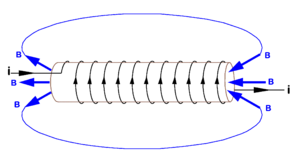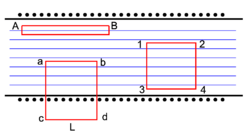Solenoid (physics)
In physics, a solenoid is a spiral of insulating wire wound around a cylinder. When a direct current passes through the wire a magnetic field is generated. Usually the cylinder is made of iron or other ferromagnetic material that enhances the magnetic field.
Magnetic field in infinitely long solenoid
By definition an "infinitely long" solenoid is so long that end effects are negligible for almost all of the solenoid. We will consider the part of a cylindrical solenoid where end effects are negligible, so that in effect we will consider an infinitely long cylindrical solenoid.
Because of cylinder (axial) symmetry, the magnetic field inside the solenoid is parallel to the cylindrical axis Z. In the figure on the left the field lines are given in blue. The fact that the field is parallel, is intuitively clear, but can be shown more rigorously.
Namely, one can show that the X-Y components of all field vectors B cancel each other. (The X-Y components are the projections of the vectors B onto a plane—the X-Y plane—perpendicular to Z). This cancellation has the consequence that only the components of the field vectors along Z contribute to the field, or in other words that the magnetic field is parallel to Z.
To show the cancellation of the vectors in the X-Y plane, we note that a cylinder has infinitely many vertical mirror planes, i.e., mirror planes that pass through the Z axis. Suppose now that an arbitrary field vector B is not parallel Z. Choose the orthogonal X and Y axis such that B is in the Z-Y plane. Note that B has a component along the Y axis. The Z-X plane is a vertical mirror plane. Reflection of B in the Z-X plane gives the vector B', which is also in the Z-Y plane. The components of B and B' along the Y axis are of opposite sign and of the same length, so they cancel each other. By reflection symmetry every B has a counterpart B' of which the X-Y components cancel.

